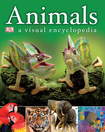ANIMALS a visual encyclopedia
ANIMALS a visual encyclopedia
Edited by Carrie Lowe and Caroline Stamps
Dorling Kindersley, 2008
ISBN #9780756640279
Ages 5 – 9 years
Nonfiction
“What is an Animal?
The animal kingdom is a vast collection of weird and wonderful creatures. Members of this group come in many different shapes and sizes, but they are all made up of cells, and they all have nerves and muscles to move and respond to the world around them. Most important, all animals eat food to make energy.”
This visual encyclopedia first defines animals and then begins with a chart showing the relationship of life as it is divided into various categories. From this introduction, filled with charts, photos, and sidebars explaining animal relationships, the book continues with information about behavior, life cycles, habitats, and endangered animals.
Following this introduction, each group of animals is defined and detailed in sections about vertebrates and invertebrates. The information is excellent and a good way to introduce any study of animals and how they interact. Bold and large photographs make the wide range of text narrative appealing and will draw in the reader. The representative animals are both familiar and unfamiliar. For example, the water bird heading in the bird section includes the Black swan, the Mallard, and the Muscovy duck.
I can see readers picking up the book to browse or using it for the information. It does not read like a typical encyclopedia and invites children to read and explore the world of animals. This book is perfect for the library, classroom, or home and it would be a wonderful gift for any child.
Activity 1
Choose an animal and read about its habitat. Identify why it lives in that particular habitat. Look up more information about the animal and read about it. Make a list of adaptations the animal has that allows it to live and thrive. Illustrate the adaptations or write an explanation of those adaptations.
Activity 2
Choose an animal from the book. Read about its life cycle. Then create your own chart to illustrate the life cycle. Don’t overlook the wide number of interesting invertebrates!
Find animal information at National Geographic Kids.
The San Diego Zoo has good animal information.
See more animal information here.
National Science Standard: growth and development of organisms; interdependent relationships in ecosystems; adaptation
Book provided by publisher


Shirley Smith Duke's Blog




